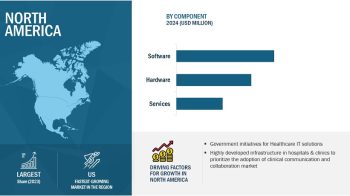Nuclear medicine is a specialized field of medicine that covers all aspects of the use of radioactive substances, through either injection or ingestion, for the diagnosis or treatment of diseases such as cancer, cardiovascular disease, and neurological diseases. The nuclear medicine/radiopharmaceuticals market is bifurcated into diagnostic and therapeutic segments. Radiopharmaceuticals in the diagnostics market are categorized as SPECT and PET, whereas radiopharmaceuticals in the therapeutics market are categorized as beta emitters, brachytherapy isotopes, and alpha emitters.
Growth in the North American nuclear medicine/radiopharmaceuticals market is likely to be centered in the U.S. Growth in the U.S. can be attributed to the focus on domestic production of Mo-99, the approval of new radiopharmaceuticals by the FDA in the U.S., FDA approval for alpha emitter, growing focus on therapeutic nuclear medicine as an alternative treatment in oncology, and growing incidence of thyroid cancer.
Traditionally, a limited number of radiopharmaceuticals, on account of their radiation-emitting nature, were approved for use in the U.S. by the FDA. However, in recent years, this scenario has changed with various radiopharmaceuticals receiving FDA approval for use in the U.S. For instance, in 2014, the FDA approved Piramal Imaging’s Neuraceq (florbetaben F18 injection) for PET Imaging of Beta-Amyloid Neuritic Plaques in the brain. Moreover, approximately half of the world’s demand for Mo-99 comes from the U.S.; however, in the U.S., the entire stock of Mo-99 is imported from foreign nuclear reactors and is not produced domestically. To counter this, the Nuclear Regulatory Commission (NRC) of the U.S. is working with companies to develop domestic production sites for Mo-99. This will help decrease the dependency on foreign nuclear reactors. For instance, SHINE Medical Technologies, a Wisconsin-based company, is developing the SHINE medical isotope production facility in Janesville, WI for the production of Mo-99 with the approval of NRC in 2015. This manufacturing plant is expected to start its commercial production by 2018 and is estimated to produce more than a quarter of the world’s supply of Mo-99. In addition, the U.S. market is expected to boost owing to the approval of alpha emitters radioisotope for the treatment of castration-resistant prostate cancer. In May 2013, the U.S. FDA approved the first alpha emitter—Xofigo (radium Ra 223 dichloride).
Canada has seen government initiatives and investment development of alternative technologies for the production of medical isotopes. This investment is focused at diversifying the sources of supply for medical isotopes such as Mo-99 and creating alternatives for reactor-based supply. Moreover, In 2010, the Government of Canada announced its decision to cease Mo-99 production at the National Research Universal (NRU) reactor in the year 2016 and ensure the security of supply of medical isotopes by investing in alternative sources of isotope production. However, as a result of the global shortage of Mo-99, the Canadian government decided to support the extension of operations of the reactor until March 2018 (Source: Government of Canada). This will help in supporting the global demand for medical isotopes in the extended period. In addition, Growing government initiatives and investments to increase the number of nuclear medicine treatment centers and promote medical isotope development are fueling the growth of the Canadian market. For instance, In May 2014, the State for Western Economic Diversification funded USD 5.5 million to support TRIUMF (Canada’s national laboratory for particle and nuclear physics) for procuring a new TR-24 cyclotron and developing the Institute for Accelerator-based Medical Isotopes (IAMI). This is aimed at securing the supply of medical isotopes for Canadians, to diagnose and treat illnesses such as cancer, heart diseases, Alzheimer’s disease, and Parkinson’s disease.

